The World Tree
You know the drill.
No, not the one that bores into the center of a planet! (Though that's an apt metaphor, come to think of it.) And likewise, I hope I'm not going to bore you with this one, because it's very long, and shiny.
Chutes and Ladders

One of the basic purposes of Mythology is to make life in the here and now cohere with our understanding of the Universe at large. By connecting the patterns of the Ordinary World to those Special Places usually inaccessible (the stars, the heavens, but also the deep recesses of the earth) the chaotic is made sensible, and a sense of communion and belonging can be achieved.
The World Tree is a predominant symbol of this connectivity, of the principle "as above, so below," which is an alchemical saying. In the shot above, the Tree is on the wall of the Staircase, which is also a means of connecting above and below. Amy's in the middle of a photo shoot, and one of her assistants is using a hair blower to make her locks wave about, as if she were flying, or floating in space. When Rory arrives with the divorce papers, Amy comes back down to earth.
And now, faced with her greatest fear -- losing Rory -- Amy ascends, climbing a proverbial beanstalk to enter Valhalla, the Hall of the Gods, where Heroes are welcomed with open arms.
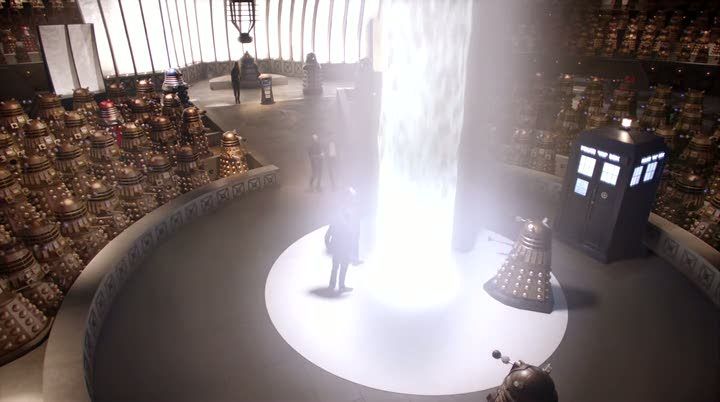
The "silver cord" is much attested in the metaphysical literature of near-death experiences, astral projection, and other out-of-body experiences. This "sutratma" is the life-thread connecting the "higher self" to the "lower self," the God-Head to the Mind, and the now-self to past lives. It is often described being smooth, long, shimmering like tinsel, an elastic cable of light.
Remember him - before the silver cord is severed, or the golden bowl is broken;
before the pitcher is shattered at the spring, or the wheel broken at the well,
and the dust returns to the ground it came from, and the spirit returns to God who gave it.
(Ecclesiastes 12:6 - 7)
But this is also the axis mundi, a World Tree connecting the Upperworld of the Dalek Parliament to the Underworld of their Asylum. This is the function of the World Tree, and in the episode it's literally the means by which our fallen angels descend into hell.
The Doctor invokes Christmas, and the Daleks start chanting for their savior, lighting themselves up like a Christmas Tree. The Parliament, of course, is the meeting point of the Daleks. The axis mundi (a shaft of Light) occupies the Center, but look what else is there -- our TARDIS, who's been positioned against other kinds of axis mundi images before -- various Trees, the Torchwood Tower, and so on. And like the axis mundi and the Daleks around her, the TARDIS is also lit up. All in the Center of the gathering.
Professor Mircea Eliade, who studied mythology, religion, and anthropology, says:
The architectonic symbolism of the Center may be formulated as follows:
1. The Sacred Mountain -- where heaven and earth meet -- is situated at the center of the world.
2. Every temple or palace -- and by extension, every sacred city or royal residence -- is a Sacred Mountain, thus becoming a Center.
3. Being an axis mundi, the sacred city of temple is regarded as the meeting point of heaven, earth, and hell.
Notice how the axis mundi is juxtaposed with a sun before it strikes the Mountain, under which lies the Asylum and the salvation of heroes of monsters alike:
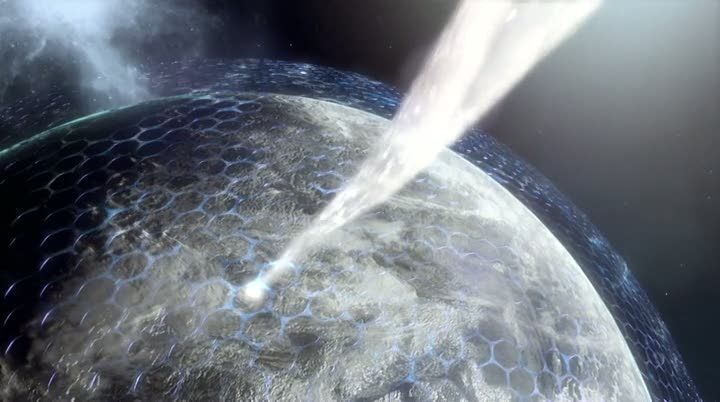

Again, quoating Mircea Eliade from The Myth of The Eternal Return:
The center, then, is pre-eminently the zone of the sacred, the zone of absolute reality. Similarly, all the other symbols of absolute reality (trees of life and immortality, Fountain of Youth, etc.) are also situated at the center.
The road leading to the center is a "difficult road" (durohana) and this is verified at every level of reality: difficult convolutions of a temple (as at Borobudur); pilgrimage to sacred places (Mecca, Hardwar, Jerusalem); danger-ridden voyages of the heroic expeditions in search of the Golden Fleece, the Golden Apples, the Herb of Life; wanderings in labyrinths; difficulties of the seeker for the road to the self, to the "center" of his being, and so on.
The road is arduous, fraught with perils, because it is, in fact, a rite of passage from the profane to the sacred, from the ephemeral and illusory to reality and eternity, from death to life, from man to the divinity. Attaining the center is equivalent to a consecration, an initiation; yesterday's profane and illusory existence gives place to a new life that is real, enduring, and effective.
All this to say, "As above, so below." Because the point of the story isn't (just) to wax philosophical about esoteric mysticism, but to explore the issues of our characters, and how they come to grips with existence in an absurd Universe.
So all this makes sense of Oswin's coming to grips with her reality and the delusions she's used to sustain herself; of the Doctor's role in making the Daleks who they are, a mirror of his dark self; of the kind of peril it takes for Amy and Rory to resolve their issues.
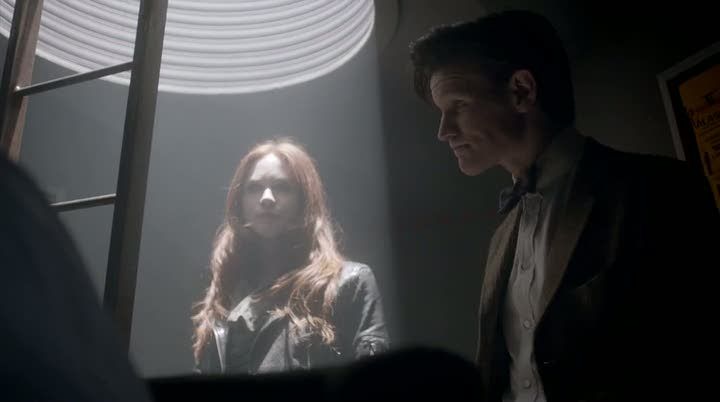
The Ladder is also kind of World Tree, a connector of different planes, but this one descends into the ground, into the Underworld. In the Asylum, there are two Underworlds, one underneath the other. Rory goes straight to deepest levels, but Amy and the Doctor make a pit stop in the escape pod of the spaceship Alaska -- an Aleut word that means "mainland" but literally translates as "the object towards which the action of the sea is directed." It's here that Amy finally gets to speak a truth of how she feels (though this isn't the deepest part of her psyche):
AMY: Is it bad that I've really missed this?
DOCTOR: Yes!
AMY: Good.
DOCTOR: I know.
The other basic feature of alchemy is the union of opposites, and that's reflected in this little revelation. It's a beat that occurred just moments ago, when the Doctor and Amy realize that the nano-cloud can convert the bodies of the living and the dead.
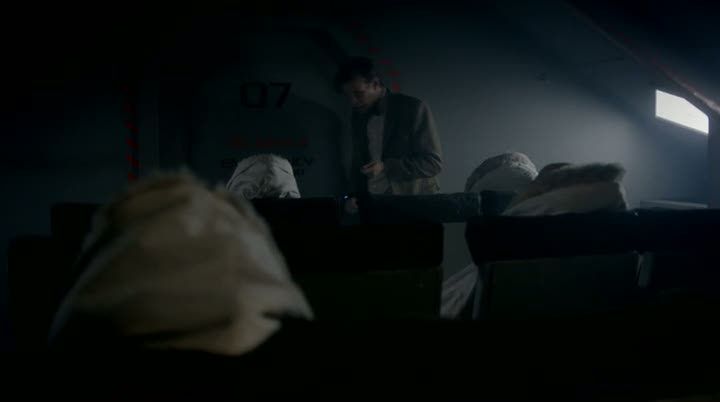
This is the door through which Amy and the Doctor escape the zombies, and it's got the number Seven printed on it. This is Amelia's number -- she was seven years old when the Doctor first dropped out of the sky into her garden with his magic box and promptly walked into a tree.
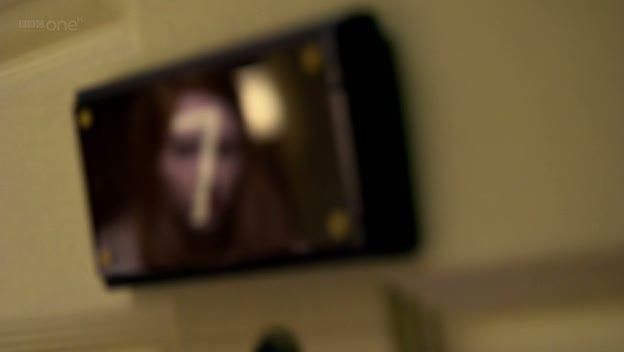

7 is the number on Amy's door in The God Complex, a room or box that contains the memory of this traumatic incident in her life. She waited for the Doctor, but he didn't come back in five minutes like he promised. And it's the number on the door through which Rory emerges while on the run in Day of the Moon (the Moon is a symbol of the subconscious, and so is Water -- this Door is on top of a gigantic dam) -- Rory is Amy's dream.
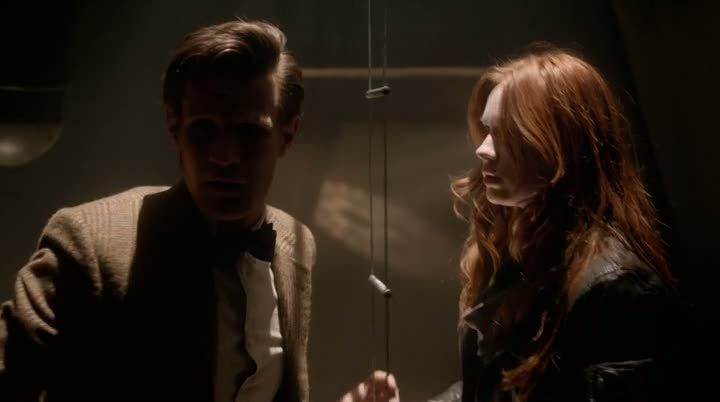
Only after they've passed through the valley of the dead and descended another ladder do they get to the stuff that's more deeply repressed -- Amy's issues with Rory, the whole business with Eggs, the Doctor's role in making the Daleks what they are.
Interesting that Rory gets deposited here without encountering the living dead -- is it because he's less repressed? Or because he's died and been reborn so many times he doesn't need that particular rite of passage anymore?
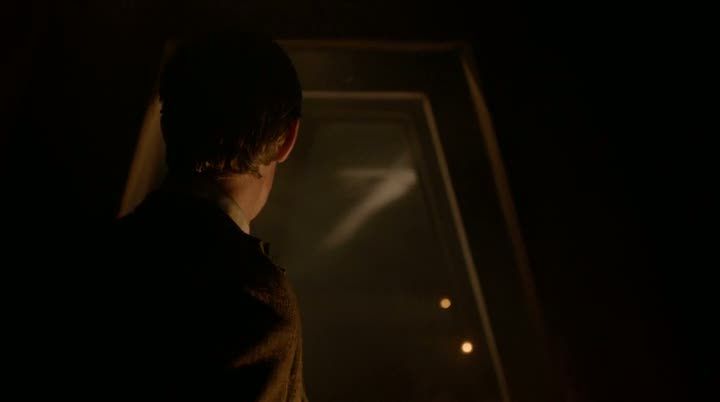
And 7 is also the number blazoned at the end of the corridor after the Doctor leaves Amy and Rory behind to go track down Oswin. This gives me a very bad feeling about Amy's fate.
In Mircea Eliade's Myth and Reality, there's a whole chapter on the mythologies of memory and forgetting. Not sure if this will apply to the Ponds, or if I'm still obsessed with Oswin, but here goes:
...[both] captivity and forgetting are a pan-Indian motif. Both misfortunes plastically express the fall of the spirit (the Self; atman, parusha) into the circle of existences and, as a consequence, loss of consciousness of the Self. Indian literature uses images of binding, chaining, and captivity interchangeably with those of forgetting, unknowing, and sleep to signify the human condition; contrariwise, images of being freed from bonds and the tearing of a veil (or the removal of a bandage from the eyes), of memory, remembering, being awakened, the waking the state, express abolishing (or transcending) the human condition: freedom, deliverance (moksha, mukti, nirvana, etc.)
The Doctor removes the veil of illusion from Oswin's eye, holding up a metaphorical mirror to help her see the truth of who she she's become, and who she is -- because she's forgotten, but now she remembers. And the image of that revelation is this:
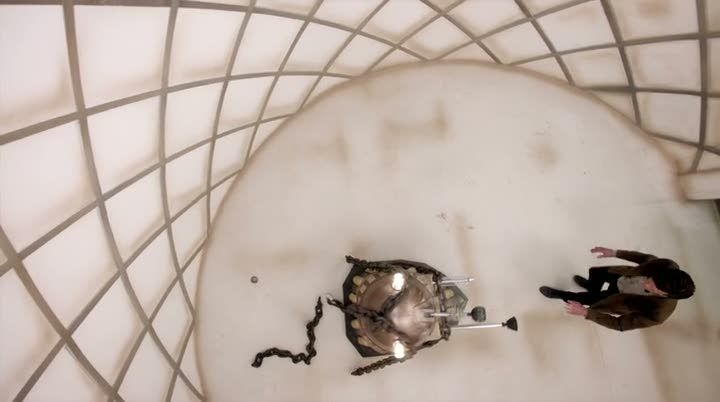
The chains holding her back shatter, and she steps forward in the glory of her Dalek nature, chanting the holy litany of who she's become, but this, this is the body, not the spirit, and the spirit wins in the end, her freedom comes in death, but also in the memories the Doctor will carry to the stars -- we never move on from the deaths of those dear to us, they simply become a part of who we are.
This is, as the Doctor puts it, "Oswin's Ladder." An inversion of Jacob's Ladder, but a ladder nonetheless, and it's Oswin's Ladder that Amy and the Doctor used for their descent. Rory, on the other hand, went straight through the navel.
In the background of all this (eggs, ex) is what Amy and Rory are going to do about their lost daughter. The big complaint against the current arc is that they act like they've forgotten their lost child, so what happens when they finally Remember? Will they go back and try to recover her? And then it's the adult River who will be forgotten.
Eliade notes that in Greek mythology, Hypnos and Thanatos -- the gods of Sleep and Death -- are twins. And in much of the mythological literature, the act of "waking" has a soteriological sense to it; the gnosis of Remembering is likened to waking up and entering Eternity.
The sufferings that constitute every human life vanish at the moment of waking. Waking, which is at the same time an anamnesis, finds expression in an indifference to History, especially to contemporary History. Only the primordial myth is important. Only the events that occurred in the past of fable are worth knowing; for, by learning them, on becomes conscious of one's true nature -- and awakens.
RORY: Will sleeping help her? Slow down the process?
OSWIN: Better hope so. Because pretty soon she's going to try to kill you.
AMY: (waking up) Ow.
DOCTOR: Amy, still with us?
RORY: Amy, it's me. Do you remember me? (Amy slaps Rory) She remembers me.
DOCTOR: Same old Amy.
No, not the one that bores into the center of a planet! (Though that's an apt metaphor, come to think of it.) And likewise, I hope I'm not going to bore you with this one, because it's very long, and shiny.
Chutes and Ladders

One of the basic purposes of Mythology is to make life in the here and now cohere with our understanding of the Universe at large. By connecting the patterns of the Ordinary World to those Special Places usually inaccessible (the stars, the heavens, but also the deep recesses of the earth) the chaotic is made sensible, and a sense of communion and belonging can be achieved.
The World Tree is a predominant symbol of this connectivity, of the principle "as above, so below," which is an alchemical saying. In the shot above, the Tree is on the wall of the Staircase, which is also a means of connecting above and below. Amy's in the middle of a photo shoot, and one of her assistants is using a hair blower to make her locks wave about, as if she were flying, or floating in space. When Rory arrives with the divorce papers, Amy comes back down to earth.
And now, faced with her greatest fear -- losing Rory -- Amy ascends, climbing a proverbial beanstalk to enter Valhalla, the Hall of the Gods, where Heroes are welcomed with open arms.

The "silver cord" is much attested in the metaphysical literature of near-death experiences, astral projection, and other out-of-body experiences. This "sutratma" is the life-thread connecting the "higher self" to the "lower self," the God-Head to the Mind, and the now-self to past lives. It is often described being smooth, long, shimmering like tinsel, an elastic cable of light.
Remember him - before the silver cord is severed, or the golden bowl is broken;
before the pitcher is shattered at the spring, or the wheel broken at the well,
and the dust returns to the ground it came from, and the spirit returns to God who gave it.
(Ecclesiastes 12:6 - 7)
But this is also the axis mundi, a World Tree connecting the Upperworld of the Dalek Parliament to the Underworld of their Asylum. This is the function of the World Tree, and in the episode it's literally the means by which our fallen angels descend into hell.
The Doctor invokes Christmas, and the Daleks start chanting for their savior, lighting themselves up like a Christmas Tree. The Parliament, of course, is the meeting point of the Daleks. The axis mundi (a shaft of Light) occupies the Center, but look what else is there -- our TARDIS, who's been positioned against other kinds of axis mundi images before -- various Trees, the Torchwood Tower, and so on. And like the axis mundi and the Daleks around her, the TARDIS is also lit up. All in the Center of the gathering.
Professor Mircea Eliade, who studied mythology, religion, and anthropology, says:
The architectonic symbolism of the Center may be formulated as follows:
1. The Sacred Mountain -- where heaven and earth meet -- is situated at the center of the world.
2. Every temple or palace -- and by extension, every sacred city or royal residence -- is a Sacred Mountain, thus becoming a Center.
3. Being an axis mundi, the sacred city of temple is regarded as the meeting point of heaven, earth, and hell.
Notice how the axis mundi is juxtaposed with a sun before it strikes the Mountain, under which lies the Asylum and the salvation of heroes of monsters alike:


Again, quoating Mircea Eliade from The Myth of The Eternal Return:
The center, then, is pre-eminently the zone of the sacred, the zone of absolute reality. Similarly, all the other symbols of absolute reality (trees of life and immortality, Fountain of Youth, etc.) are also situated at the center.
The road leading to the center is a "difficult road" (durohana) and this is verified at every level of reality: difficult convolutions of a temple (as at Borobudur); pilgrimage to sacred places (Mecca, Hardwar, Jerusalem); danger-ridden voyages of the heroic expeditions in search of the Golden Fleece, the Golden Apples, the Herb of Life; wanderings in labyrinths; difficulties of the seeker for the road to the self, to the "center" of his being, and so on.
The road is arduous, fraught with perils, because it is, in fact, a rite of passage from the profane to the sacred, from the ephemeral and illusory to reality and eternity, from death to life, from man to the divinity. Attaining the center is equivalent to a consecration, an initiation; yesterday's profane and illusory existence gives place to a new life that is real, enduring, and effective.
All this to say, "As above, so below." Because the point of the story isn't (just) to wax philosophical about esoteric mysticism, but to explore the issues of our characters, and how they come to grips with existence in an absurd Universe.
So all this makes sense of Oswin's coming to grips with her reality and the delusions she's used to sustain herself; of the Doctor's role in making the Daleks who they are, a mirror of his dark self; of the kind of peril it takes for Amy and Rory to resolve their issues.

The Ladder is also kind of World Tree, a connector of different planes, but this one descends into the ground, into the Underworld. In the Asylum, there are two Underworlds, one underneath the other. Rory goes straight to deepest levels, but Amy and the Doctor make a pit stop in the escape pod of the spaceship Alaska -- an Aleut word that means "mainland" but literally translates as "the object towards which the action of the sea is directed." It's here that Amy finally gets to speak a truth of how she feels (though this isn't the deepest part of her psyche):
AMY: Is it bad that I've really missed this?
DOCTOR: Yes!
AMY: Good.
DOCTOR: I know.
The other basic feature of alchemy is the union of opposites, and that's reflected in this little revelation. It's a beat that occurred just moments ago, when the Doctor and Amy realize that the nano-cloud can convert the bodies of the living and the dead.

This is the door through which Amy and the Doctor escape the zombies, and it's got the number Seven printed on it. This is Amelia's number -- she was seven years old when the Doctor first dropped out of the sky into her garden with his magic box and promptly walked into a tree.


7 is the number on Amy's door in The God Complex, a room or box that contains the memory of this traumatic incident in her life. She waited for the Doctor, but he didn't come back in five minutes like he promised. And it's the number on the door through which Rory emerges while on the run in Day of the Moon (the Moon is a symbol of the subconscious, and so is Water -- this Door is on top of a gigantic dam) -- Rory is Amy's dream.

Only after they've passed through the valley of the dead and descended another ladder do they get to the stuff that's more deeply repressed -- Amy's issues with Rory, the whole business with Eggs, the Doctor's role in making the Daleks what they are.
Interesting that Rory gets deposited here without encountering the living dead -- is it because he's less repressed? Or because he's died and been reborn so many times he doesn't need that particular rite of passage anymore?

And 7 is also the number blazoned at the end of the corridor after the Doctor leaves Amy and Rory behind to go track down Oswin. This gives me a very bad feeling about Amy's fate.
In Mircea Eliade's Myth and Reality, there's a whole chapter on the mythologies of memory and forgetting. Not sure if this will apply to the Ponds, or if I'm still obsessed with Oswin, but here goes:
...[both] captivity and forgetting are a pan-Indian motif. Both misfortunes plastically express the fall of the spirit (the Self; atman, parusha) into the circle of existences and, as a consequence, loss of consciousness of the Self. Indian literature uses images of binding, chaining, and captivity interchangeably with those of forgetting, unknowing, and sleep to signify the human condition; contrariwise, images of being freed from bonds and the tearing of a veil (or the removal of a bandage from the eyes), of memory, remembering, being awakened, the waking the state, express abolishing (or transcending) the human condition: freedom, deliverance (moksha, mukti, nirvana, etc.)
The Doctor removes the veil of illusion from Oswin's eye, holding up a metaphorical mirror to help her see the truth of who she she's become, and who she is -- because she's forgotten, but now she remembers. And the image of that revelation is this:

The chains holding her back shatter, and she steps forward in the glory of her Dalek nature, chanting the holy litany of who she's become, but this, this is the body, not the spirit, and the spirit wins in the end, her freedom comes in death, but also in the memories the Doctor will carry to the stars -- we never move on from the deaths of those dear to us, they simply become a part of who we are.
This is, as the Doctor puts it, "Oswin's Ladder." An inversion of Jacob's Ladder, but a ladder nonetheless, and it's Oswin's Ladder that Amy and the Doctor used for their descent. Rory, on the other hand, went straight through the navel.
In the background of all this (eggs, ex) is what Amy and Rory are going to do about their lost daughter. The big complaint against the current arc is that they act like they've forgotten their lost child, so what happens when they finally Remember? Will they go back and try to recover her? And then it's the adult River who will be forgotten.
Eliade notes that in Greek mythology, Hypnos and Thanatos -- the gods of Sleep and Death -- are twins. And in much of the mythological literature, the act of "waking" has a soteriological sense to it; the gnosis of Remembering is likened to waking up and entering Eternity.
The sufferings that constitute every human life vanish at the moment of waking. Waking, which is at the same time an anamnesis, finds expression in an indifference to History, especially to contemporary History. Only the primordial myth is important. Only the events that occurred in the past of fable are worth knowing; for, by learning them, on becomes conscious of one's true nature -- and awakens.
RORY: Will sleeping help her? Slow down the process?
OSWIN: Better hope so. Because pretty soon she's going to try to kill you.
AMY: (waking up) Ow.
DOCTOR: Amy, still with us?
RORY: Amy, it's me. Do you remember me? (Amy slaps Rory) She remembers me.
DOCTOR: Same old Amy.